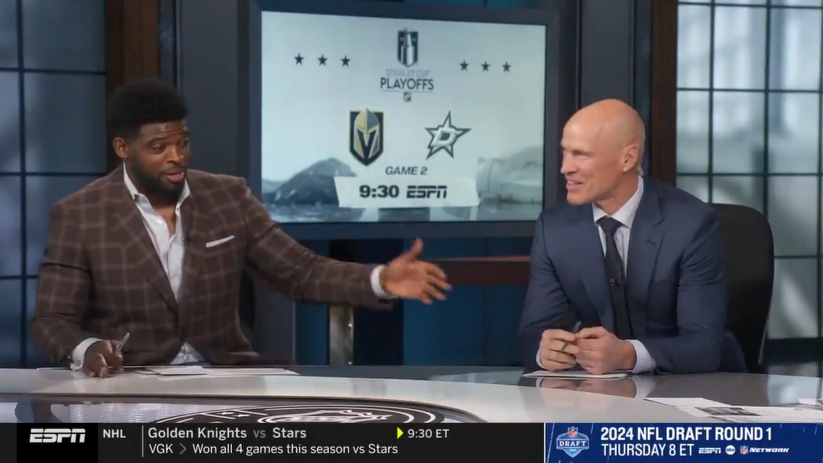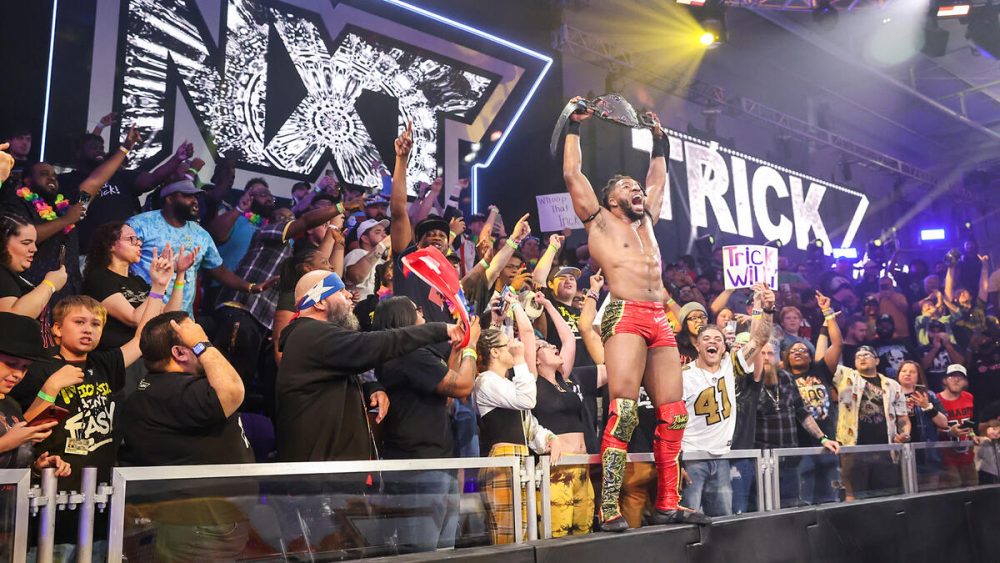What would you do if you were at ESPN? Seriously, what would you do?
Last night, no one truly had the answers. And yet, many of us thought we had some when it came to how ESPN approached the frightening on-field collapse of Buffalo Bills safety Damar Hamlin during his team’s highly anticipated Monday Night Football showdown with the Cincinnati Bengals.
There is no question that the NFL handled this nightmare scenario poorly. The decision to give the teams merely five minutes to resume play after the ambulance moved Hamlin off the field deserves all the criticism in the world for its callousness. That it took both head coaches Sean McDermott and Zac Taylor–and the players’ apparent refusal to go back onto the field–to press the NFL into suspending the game further brings the league’s protocols in question. In a serious health situation that the league should always be prepared for, it had to recover its own fumble.
Yet ESPN began to catch a bit of flak as well, though that’s par for the course for the network. As usual, the most immediate and undoubtedly raw feedback came from the echo chambers of Twitter and Facebook. Social media, and certainly millions of folks offline, caught embers from the viral clips of Hamlin’s collapse and the reporting from the announce team before becoming engulfed in the flames of our reactions.
However, in the press box and on the field in Paycor Stadium, the MNF crew had multiple unenviable tasks. All of them were handled with much more care and consideration than the average viewer would have thought.
For starters, the network went to their first commercial break after the incident with an expectation that Hamlin would come off the field on his own power or at least be assisted to the locker room. This is actually the standard procedure that we see weekly in the NFL, for an injury might be uncomfortable for the viewers to sit through. There are hopes that a player would improve or at least be taken care of quickly, because “the show must go on.”
But as the situation became more dire and the medical personnel was administering CPR to Hamlin, the broadcast team of Joe Buck, Troy Aikman and Lisa Salters began to focus on reactions from the players. Without the ability to watch the medics or see Hamlin, this was the first of several on-the-fly decisions made to both inform the viewers and, for better or worse, fill up airtime while producers needed to pivot from play-by-play announcing to real-time news coverage.
Yet the most important job of any broadcaster is to disseminate relevant and accurate information based on their given knowledge of an ongoing situation. As noted by Timothy Burke, on four separate occasions Buck and Aikman mentioned that the NFL informed the teams that they had five minutes to resume play after Hamlin was taken off the field in an ambulance. There were six other mentions of that across Westwood One Radio and ESPN Deportes. But the league claims differently, and the debate itself will rage for several days.
So to wrap this up, last night the statement that the game would resume after a five-minute warmup was attributed directly to the NFL on both ESPN and ESPN Deportes, & was stated as fact a total of ten times in the three hour broadcast across those networks & Westwood One radio. https://t.co/0jzrFAYn6x
— Timothy Burke (@bubbaprog) January 3, 2023
While managing the situation in real-time from Cincinnati, it’s clear that the MNF team was also buying time for the in-studio teams in New York and Washington, DC. Wrangling together a studio show in the midst of significant breaking news in sports can be a challenge in the best of times – a stunning trade or free agent signing, disciplining of a player or coach or even the death of a legend.
In those moments, even if the timing is unpredictable, the context surrounding the moment may not be as there is a wealth of knowledge on how similar situations have been dealt with before. We expect player movement based on rumors and reports. We know that someone can be punished for an egregious violation. Storytelling is part of processing grief when a sports figure dies.
This was different. Way different. Just like all of us watching from home, Suzy Kolber, Adam Schefter and Booger McFarland were processing the moment in real-time from their studio desk in New York …
ESPN in the tough situation where nobody has much to say because there isn’t much to say. They cannot breakaway from covering this story but it’s just incredibly uncomfortable to really say much. This is just extremely tough to navigate. pic.twitter.com/O9dOqpLpfi
— Awful Announcing (@awfulannouncing) January 3, 2023
Not all was perfect as some called out Kolber (and just about anyone else online) for apparent tone deafness when questioning how, if at all, the game would be resumed. To be somewhat fair, it is a legitimate question to coincide with rightful concerns about how the NFL plans to support the players through this event in the coming days. Yet the timing may have not given the best optics.
Fortunately for fans watching live, ESPN handed off its coverage to SportsCenter with Scott Van Pelt as the veteran broadcaster picked up the load for Kolber, Schefter and McFarland. Not all that different from what we see from ABC News or its peers, Van Pelt’s show in DC became the news desk that was needed last night.
Van Pelt deftly called upon the MNF announce team, reporters at the hospital and available in-house commentators to provide any available information, answer questions and provide perspectives based on their roles and experiences. Arguably the most critical thing his studio team had done was gather and report a timeline from when Hamlin collapsed to when the league called for the game to be suspended. It dovetails well with Buck and Aikman’s mentions of the NFL’s attempt to resume the game before ultimately suspending play.
The ordeal was best summed up by ESPN analyst and former NFL safety Ryan Clark during the makeshift SportsCenter with Van Pelt.
"[NFL] can say whatever it wants to say about [playing the game]… a group of men locked arms on different sides of a sideline and said no we're not."- SVP
"I'm so glad that these guys didn't have to go back out on this field tonight and try to play a damn game."- Ryan Clark pic.twitter.com/fHhUlBVylA
— Awful Announcing (@awfulannouncing) January 3, 2023
“Scott, I can only imagine what it’s taking for you to be hosting a show about football right now,” Clark said. “Neither of us are emotionally equipped for what we are being asked to do. Imagine being in (the players’) shoes. None of those men are emotionally equipped to handle this.”
Later in the telecast, Stephen A. Smith, the network’s best-known commentator, provided his perspective.
Stephen A. Smith Speaks On The Damar Hamlin Situation 🙏🏽 pic.twitter.com/qrT0Sokn79
— NFL Daily (@SportsContent23) January 3, 2023
Despite giving well-measured thoughts, Smith’s presence riled up many, including one famed biographer. That said, the most notable of Smith’s words were about being reminded of the brotherhood among NFL players.
“We hear so much as reporters, as commentators, as pundits and people who get paid to chronicle this league,” he reflected. “We hear about (the players) talk about family and then you see something like this, and you realize how real it is.” At least Smith knew the assignment – this wasn’t time for a ‘take,’ unlike his friend and former colleague Skip Bayless.
If there was something missing from the immediate coverage, it was the lack of medical commentary. That was offered in droves on Twitter from actual medical professionals and those who aren’t. However, it’s not so easy to defend or criticize the network for not bringing on an expert right away.
On one hand, the still-ongoing coronavirus pandemic raised the profiles of many doctors who can disseminate clear and concise information while drawing upon their experiences to ponder the next steps. If ESPN can have contributors explaining injuries in relation to fantasy sports, that’s the arguable baseline to have an expert explain the critical medical procedures use to help Hamlin. However, just as psychologists are restricted from offering diagnoses on public figures in the media, perhaps there’s a similar coda for doctors in this case, as a player experienced a severe medical episode in front of the world. If adding a doctor on air was in consideration, then ESPN played it safe.
The other truly notable part of ESPN’s coverage was that it eventually went over an hour without commercials.
The last commercial ESPN aired was for the new Ant-Man movie. They’ve gone over an hour without a commercial break since.
— Awful Announcing (@awfulannouncing) January 3, 2023
Consider this another part of standard procedure – it would be unwise and insensitive for a network to run any ads to begin with, even though mistakes do happen. (ESPN did run ads before this during the repeated throws to break as the situation developed.) Flippant critics will claim that ESPN still needed to make its money, but that’s not entirely inaccurate since those ad dollars were likely in Bristol’s coffers long before the broadcast. (TV advertising doesn’t function in real-time commerce like a retail store.)
We are a cynical public, but the most aware of us know that the emotions displayed by those on the air last night were not shown for branding purposes. During the uninterrupted ad-free time, the question “what else is there to talk about?” came up often on Twitter; an understandable one in the immediate moments. Yet the truth is that we were tuning in for assurance that we weren’t witnesses to a tragedy.
Instead, in the waning moments of last night, what we got was honesty, confusion, fear, and pain. We got reality. In other words, what we got from ESPN was a level of humanity that the NFL seemed unable to provide.







